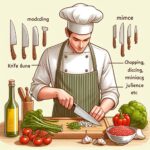The best knife to cut steak is a sharp, straight-edged steak knife. This type of knife ensures precise cuts without tearing the meat.
Selecting the ideal steak knife can elevate your dining experience, ensuring every slice is effortless and enjoyable. A top-quality steak knife combines superior cutting performance with comfort and durability. It’s an indispensable tool for meat lovers and a staple in any well-set dining table.
High-carbon stainless steel blades are often preferred for their sharpness and rust resistance. Well-balanced knives with ergonomically designed handles offer better control and reduce hand fatigue during use. Remember, the right knife not only enhances your meal but is also a reflection of personal style and culinary dedication. Whether entertaining guests or enjoying a solo dinner, the right steak knife is key to a satisfying meal.

Introduction To Steak Knives
The right steak knife is not just a piece of cutlery on your table; it’s an extension of the dining experience for any meat lover. Imagine the sizzling sound of a perfectly grilled steak as it arrives at your table, the aroma enticing your senses. Now, to honor that culinary masterpiece, a precise, effortless cut is essential. This is why choosing the perfect steak knife matters enormously — it’s the unsung hero of a carnivore’s dining ritual.
Using the correct steak knife is paramount for several reasons. Not only does it enhance your dining pleasure, but a suitable knife also respects the craftsmanship that went into cooking the steak. A clean cut maintains the steak’s juiciness and flavor, which could otherwise be lost through tearing or sawing with an inferior blade.
- A sharp edge glides through meat with minimal effort.
- Ergonomic handles provide comfort and control.
- Durability ensures a lasting investment.
Identifying a high-quality steak knife is all about understanding what makes it stand out. The anatomy of a steak knife is designed specifically for cutting through fibers of meat with precision — a fine balance between sharpness and strength.
A good steak knife typically features:
| Feature | Description |
|---|---|
| Blade Material | High-carbon stainless steel for sharpness retention and corrosion resistance. |
| Edge Type | Straight for smooth cuts or serrated for tougher meats. |
| Handle Comfort | Contours to hand, made from durable materials like wood or composites for a secure grip. |
Besides these features, the best steak knives also boast a full tang, where the blade extends into the handle, for better balance and strength. Weight and balance are also carefully considered to ensure that the knife feels like an extension of your hand — for a seamless transition from plate to palate.
Types Of Steak Knives: Making The Cut
Every steak connoisseur knows that the right knife is essential for a perfect dining experience. Not only does a premium steak knife glide effortlessly through succulent meat, it also adds a touch of class to the table setting. Understanding the different types of steak knives and what sets them apart is crucial for making the best choice. Let’s delve into the world of steak knives to help you make an informed cut.
Serrated Vs. Straight-edge Steak Knives: Pros And Cons
Choosing between a serrated and a straight-edge steak knife is a matter of personal preference and understanding their distinct features. Here’s a quick overview:
| Serrated Steak Knives | Straight-Edge Steak Knives | |
|---|---|---|
| Edge Retention | Longer-lasting sharpness due to tooth-like edge | Requires more frequent sharpening |
| Cutting Technique | Sawing motion, ideal for tougher meats | Smooth slicing, a more refined dining experience |
| Maintenance | More challenging to sharpen at home | Easier to sharpen but needs it more often |
| Performance Over Time | Maintains performance longer without upkeep | Best performance when maintained properly |
Japanese Vs. German Steel: A Culinary Clash
The debate between Japanese and German steel steak knives is a tale of precision and durability. Here are the key characteristics:
- Japanese Steel: Known for its incredible sharpness, Japanese steel allows for precision cutting. Its higher carbon content makes it harder yet potentially more brittle.
- German Steel: Valued for toughness, German steel knives offer excellent durability. They’re slightly softer, making them less prone to chipping and easier to maintain.
Choice of Steel depends on preference for sharpness versus toughness, as well as willingness to invest time in maintenance.
Handle With Care: Material Choices For Steak Knife Handles
A knife handle affects both the aesthetic and the functionality of a steak knife. Common material choices include wood, plastic, and stainless steel, each with its unique set of benefits:
- Wood Handles: Offer a classic look with a warm feeling but require more maintenance to avoid water damage.
- Plastic Handles: Provide a lightweight option that is easy to care for, although it might lack the premium feel.
- Stainless Steel Handles: Deliver durability and a modern appearance, but can be slippery if not properly textured.
Selecting the right handle material is critical for balance, comfort, and longevity as it complements the blade’s characteristics.
Top Contenders For The Title Of ‘best Steak Knife’
Delving into the realm of culinary delights, a perfect steak dinner resonates with the symphony of taste, texture, and tenderness. And what enhances this gastronomic experience? None other than a seamlessly gliding steak knife. Picking the best steak knife is not just about design or brand prestige; it’s about performance, comfort, and durability. Discerning chefs and steak enthusiasts alike yearn for the superior cut, and we’re here to dissect the top contenders vying for the prestigious title of ‘Best Steak Knife’.
The Classic Choice: Wüsthof And Henckels
Steeped in tradition, the Wüsthof and Henckels knives have been synonymous with top-notch quality for generations. Both brands boast precision-forged blades, crafted for a clean cut through the most succulent steaks.
- Wüsthof’s Precision Edge Technology assures remarkable sharpness and edge retention.
- Henckels’ high carbon stainless steel construction guarantees resilient, corrosion-resistant blades.

Innovation In Cutting: Shun And Global
Embracing modernity, Shun and Global knives are the epitome of innovative design. Shun knives, originating from Japan, feature VG-MAX steel that provides a razor-sharp, fine-edge, perfect for precision slicing. Global knives, on the other hand, are recognized for their one-piece construction and unique Cromova steel that ensures edge retention and stain resistance.
Budget-friendly Blades: Victorinox And Mercer Culinary
Quality steak knives don’t have to break the bank, and Victorinox and Mercer Culinary prove just that. Victorinox, renowned for their Swiss Army knives, brings that same reliability and efficiency to the dinner table. Mercer Culinary offers ergonomically designed handles with high-carbon stainless steel blades that balance quality with affordability.
Artisanal Craftsmanship: Laguiole And Cutipol
For steak knife connoisseurs, Laguiole and Cutipol bring a touch of artisanal elegance. Each Laguiole knife is a work of art, with handcrafted handles and sleek blades that glide through steak effortlessly. Cutipol boasts the perfect blend of modern design and traditional techniques, offering knives that are both stylish and practical.
| Brand | Key Features | Price Range |
|---|---|---|
| Wüsthof | Precision Edge Technology, Forged Blades | Premium |
| Henckels | High Carbon Stainless Steel, Corrosion-Resistant | Premium |
| Shun | VG-MAX Steel, Japanese Craftsmanship | Premium |
| Global | One-Piece Construction, Cromova Steel | Premium |
| Victorinox | Swiss Reliability, Stainless Steel Blades | Mid-Range |
| Mercer Culinary | Ergonomic Design, High-Carbon Steel | Mid-Range |
| Laguiole | Handcrafted, Signature Bee Emblem | High-End |
| Cutipol | Modern Design, Artisan Craftsmanship | High-End |
Always hand wash to maintain blade sharpness.
Use a honing steel regularly to align the knife edge.
Store in a knife block or sheath to prevent accidents.
Avoid cutting on hard surfaces such as glass or stone.
Steak Knife Features: Sharpening Your Knowledge
Welcome to our discerning guide on Steak Knife Features. Whether you’re a seasoned chef or a casual home cook, knowing the ins and outs of your steak knife can elevate your dining experience. Slice through our insights and refine your culinary toolkit with the perfect steak-cutting companion.
Blade Durability: Stainless Steel Vs. High-carbon Steel
Blade durability is crucial for a steak knife that remains a cut above the rest. Two popular materials face off in the culinary world: Stainless Steel and High-Carbon Steel.
- Stainless Steel: Renowned for its resistance to rust and corrosion, stainless steel requires less maintenance, making it ideal for those seeking convenience. On the other hand, it’s typically less sharp than high-carbon steel.
- High-Carbon Steel: This material boasts superior sharpness and easier resharpening. It does, however, demand more care to prevent rust, making it a favorite amongst professionals.
Choose based on your preference: durability and low maintenance or maximum sharpness with a bit more upkeep?
Edge Retention: What To Look For
Edge retention determines how long a knife stays sharp before it requires resharpening. High-quality knives boast an edge that endures rigorous use. When selecting a steak knife:
- Examine the blade’s hardness. A higher Rockwell Hardness Scale rating often indicates longer edge retention.
- Consider knives labeled as having a precision-forged edge, which adds to their sharpness and durability.
- Seek out full tang construction, where the blade extends into the handle, offering better balance and sturdiness.
The key lies in finding a harmonious blend of toughness and wear resistance.
Handle Ergonomics And Design: Comfort Meets Style
A steak knife should feel like an extension of your hand. Handle ergonomics play a pivotal role in comfort and control when slicing through a succulent steak:
| Feature | Benefit |
|---|---|
| Contoured Handles | They conform to your grip, providing a secure and natural feel. |
| Material | Materials such as wood, rubber, or composite offer a stylish look with either traditional or modern appeal. |
| Balanced Weight | A well-balanced knife offers greater control and reduces hand fatigue, important for comfortable dining. |
Ensure the steak knife has a stylish yet functional handle to complement your table setting while promising a comfortable cutting experience.

Caring For Your Steak Knives: Longevity And Performance
A set of high-quality steak knives is a significant investment for any kitchen connoisseur. To ensure that these culinary tools perform at their best and stand the test of time, proper care is essential. This section delves into the key practices of maintaining steak knives, covering everything from cleaning techniques to adequate storage solutions. By adhering to these maintenance guidelines, your knives will continue to make precise cuts and remain a centerpiece of your culinary arsenal for years to come.
Proper Cleaning Techniques: Ensuring Hygiene And Blade Integrity
Maintaining a clean and hygienic set of steak knives is crucial for both safety and longevity. After use, it’s recommended to wash knives by hand with warm, soapy water. This process prevents the harsh conditions of a dishwasher from damaging the blade’s edge and handle material. Here are steps to follow for optimal cleaning:
- Rinse the knife under warm water to remove any residual food particles.
- Use a soft sponge with dish soap to gently clean the blade and handle.
- Carefully dry the knife with a soft towel to prevent water spots and corrosion.
- Avoid soaking knives in water as this can lead to rust and handle deterioration.
Sharpening Your Knives: Methods And Maintenance
Sharp knives are safer and more efficient. For steak knives, maintaining a razor-sharp edge ensures a seamless dining experience. While many knives come with a factory edge, regular use dulls blades over time. Consider these sharpening options:
- Manual sharpeners: Convenient for quick touch-ups.
- Whetstones: Offer the most control for a precise edge.
- Professional sharpening: Recommended for maintaining optimal blade geometry.
Sharpening frequency depends on use but aim for at least twice a year or whenever you notice a decline in cutting performance. Remember, always follow the manufacturer’s instructions to avoid accidentally damaging the knife’s edge.
Storage Solutions: Protecting Your Investment
Proper storage is critical for protecting your steak knives from unnecessary wear and tear. Rather than jumbling knives in a drawer, consider these safer alternatives:
| Storage Type | Benefits |
|---|---|
| Knife block | Keeps blades separate and protected |
| Magnetic strip | Provides easy access while preventing scratches |
| Blade guards or sheaths | Offer protection during storage in drawers |
Select a storage solution that not only safeguards the knives but also complements your kitchen’s aesthetics. Additionally, ensure your knives are clean and dry before storage to prevent any potential damage.
Expert Tips For Selecting And Using Your Steak Knife
Embracing the carnivorous delights of a succulent steak requires more than just a refined palate—it demands the right tools. Precision cutting accentuates the dining experience, letting you savor each piece without a struggle. With a plethora of options in the market, choosing the perfect tool can be daunting. Fret not, for this guide simplifies the selection process and offers tried-and-tested usage tips that will raise your steak enjoyment to new heights. Whether a professional chef or home cook, mastering the art of steak cutting is a skill worth its weight in silver.
Matching Knife To Steak Cut: A Guide To Perfect Pairings
Finding the ideal knife for your steak cut is not just about superiority in craftsmanship, it’s about chemistry. Consider the following pairings to elevate your steak indulgence:
- Serrated Blades – Ideal for well-done steaks, offering a sawing action that cuts without pressure.
- Straight-Edged Knives – Best suited for tender cuts like filet mignon, efficiently slicing without tearing the fibers.
- Hollow Edge Knives – Recommended for juicy or fatty steaks, where indents in the blade prevent sticking and promote a clean cut.
Cutting Techniques: Enhance Your Culinary Experience
Efficient cutting techniques transform steak consumption into an art form. Execute the perfect slice by:
- Placing the blade at an angle, aiming for thin, even pieces that highlight the meat’s tenderness.
- Slicing against the grain to shorten muscle fibers, which ensures a melt-in-your-mouth experience.
- Using gentle sawing motions for serrated knives, preserving the integrity of the steak’s crust.
The Role Of Aesthetics In Table Setting: Choosing Visually Appealing Steak Knives
While functionality reigns, the visual allure of your steak knives should not play second fiddle. An enchanting table setting includes knives that:
- Complement your existing flatware and dining decor for a cohesive look.
- Feature high-quality materials like stainless steel or damascus blades, exuding elegance.
- Sport ergonomically designed handles for comfort, paired with stunning aesthetics.
Remember, a visually stunning knife not only enhances the ambience but also acts as a conversation starter, bisecting the barrier between mere eating and a true dining episode.
A Cut Above The Rest
Finding the perfect knife to slice through a succulent steak isn’t just about having a meal; it’s an experience that enhances the pleasure of dining. A top-tier steak knife is the silent hero that meticulously ensures every cut is precise, retaining the steak’s juiciness and flavor. As we reflect upon our quest for the best steak knife, let’s distill the insights gained and affirm our top pick that stands a cut above the rest.
Recap Of Key Considerations When Choosing A Steak Knife
Before we unveil our final decision, a brisk recounting of critical factors is crucial in validating our choice:
- Blade Sharpness: The essential attribute of any steak knife, a razor-sharp edge promises a smooth, effortless glide through the meat.
- Blade Material: High-carbon stainless steel leads the pack, renowned for durability and resistance to corrosion.
- Handle Comfort: Ergonomically designed handles promise a secure grip and a stress-free dining experience.
- Edge Type: Choices vary from straight-edge for clean slices to serrated for textured cuts, depending on personal preference.
- Balance and Weight: A well-balanced knife feels like an extension of your hand, ensuring precision and control.
The Verdict: Balancing Quality, Price, And Personal Preference
The ultimate steak knife strikes a harmonious balance between exemplary quality, affordability, and individual taste. Recognizing that each steak aficionado has unique priorities, our recommendation caters to the discerning diner seeking a premium experience without overspending. The chosen knife showcases a perfect amalgamation of a high-carbon stainless steel blade with a fine, non-serrated edge for a clean cut, bolstered by an ergonomic handle that sits comfortably in the palm. As for the price tag, it positions itself in the sweet spot—neither exorbitant nor compromises on quality.
| Feature | Description | Benefit |
|---|---|---|
| Blade Sharpness | Razor-sharp edge with high durability | Effortless cutting, retaining steak’s integrity |
| Handle Comfort | Ergonomic design | Secure grip, reduced hand fatigue |
| Balance and Weight | Optimized for control | Precision in every cut, enhancing the dining experience |
Personal preferences in style and cutting experience have been considered, recognizing that no one size fits all. The culmination of diligent research and expert opinion elevates this knife as the quintessential choice for both casual diners and steak connoisseurs alike.

Conclusion
Selecting the ideal steak knife can elevate your dining experience substantially. Quality cutlery guarantees precision cuts and enduring satisfaction. Remember, the best knife amalgamates sharpness, comfort, and durability. Equip your kitchen with the right tools, and enjoy steak dinners that impress time and time again.
Bon appétit!







